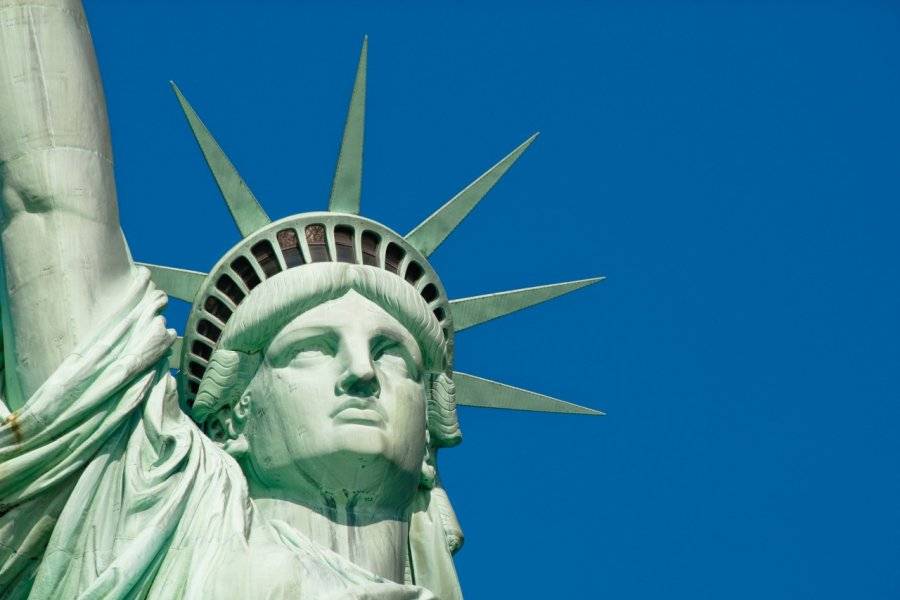Go there and contact

This great lady is the emblem of New York. Shivers are guaranteed when the boat approaches it to dock on Liberty Island.
No matter how familiar you feel with the statue, no matter how many times you tell yourself it's not that big, the thrill is inevitable as you approach the building by boat. Everyone on the ferry, brandishing their cameras to immortalize the moment. This grand dame is to New York what the Eiffel Tower is to Paris. All the more so as France is closely involved in its history, the statue having been offered, as a sign of fraternity, to the American people by the French. The idea for the gift came from Edouard Laboulaye, a politician and lover of American history. In 1865, when the United States promulgated the amendment banning the use of slavery, Edouard Laboulaye discussed with sculptor Frédéric Auguste Bartholdi the possibility of offering a huge statue to encourage America in its drive for democracy and freedom, and to consecrate the friendship between France and the United States. The proposal was no coincidence, since the young sculptor Bartholdi had been working on a very similar project for Egypt not long before: he had imagined a statue he intended to call L'Orient éclairant le Monde (The East Enlightening the World ), which would have acted as a lighthouse north of the Suez Canal. After reworking the plans, Auguste Bartholdi imagined a statue representing the Roman goddess Libertas, with a torch and a table of laws inscribed with the date of the United States' Declaration of Independence, 1776. Several hypotheses have been put forward as to which face inspired Bartholdi. Many believe that he was inspired by his mother's face to depict the features of Liberty. Standing on Liberty Island, in the middle of New York harbor, it has become one of the most endearing monuments in the United States, and a symbol of freedom the world over. It was built between 1874 and 1884, its steel structure benefiting from the lights of the great Gustave Eiffel. And it took all the efforts of the newspaper magnate of the time, Joseph Pulitzer, to raise the funds needed to build it, on his lonely islet not far from Ellis Island. In 1986, after several years of refurbishment, the statue celebrated its centenary with great fanfare, attracting over 15 million visitors. Up close, it is gigantic. Perched on a 30 m pedestal resting on 20 m high star-shaped ramparts, there are 354 steps to climb to reach its crown. The statue itself weighs 225 tonnes. Few people know it, but at the foot of the statue are broken chains, symbolizing the struggle for freedom and against tyranny. The statue's crown has 7 rays, symbolizing the 7 continents. From toe to head, the statue measures 33 meters. Inside the pedestal is a plaque engraved with a sonnet by Emma Lazarus, called The New Colossus. The end of the sonnet is the most famous part: "Send me your tired, your poor, Send me your cohorts who yearn to live free...". The ferry takes you to the foot of the statue and then to Ellis Island, home of the Immigration Museum. The 354 steps of a circular staircase (there's also an elevator) will take you under Madame's tunic and up to the tenth-floor observatory in the crown, from which you can admire New York harbor and the skyline. If you don't want to stop at Liberty Island, you can simply take the free ferry to Staten Island. This ferry deliberately passes close to the statue for tourists.
Access to the statue was closed following the attacks of September 11, 2001. The crown was reopened on July 4, 2009, Independence Day. Access is still limited to a maximum of 10 people at a time, and the tour is led by a National Park Service ranger. To gain access to the crown, you'll need to book months in advance! Internet reservations required. When you buy your ticket online, choose the option that gives you access to the crown. You'll have to pay a surcharge to visit it, of the order of a few cents. What's more, you'll automatically have access to the pedestal. Access to the pedestal is the same price, and can be booked on its own if, for example, there's no room left to visit the crown during your stay. For the pedestal, too, you need to plan well in advance. Depending on world events, the crown is sometimes closed for long periods, for example as part of anti-terrorism plans, during major storms (such as Hurricane Sandy in 2012) or during the Covid-19 pandemic.
In May 2019, a new museum dedicated to the history of the statue was inaugurated on Liberty Island. A visit to this museum is included in the normal admission price. The futuristic-looking building has integrated the collection of the former small museum already dedicated to the statue, which stood at the foot of the statue, but was small. The new, comprehensive museum looks back at the statue's manufacturing process, with an immersion in Frédéric-Auguste Bartholdi's workshops, and then at his influence over the centuries and his legacy. The highlight of the show is the original torch, with its weather-resistant glass panels, installed in 1886 and replaced in 1985.
Did you know? This review was written by our professional authors.
Members' reviews on STATUE OF LIBERTY
The ratings and reviews below reflect the subjective opinions of members and not the opinion of The Little Witty.

The best at New York (Manhattan) and around

CHEZ FRANCIS

HOME KITCHEN

LOULOU












Vous adorerez la promenade en foire terminale qui vous emmène sur l'île, puis l'exploration autour de l'île, et vous connaîtrez l'histoire de la Statue de la Liberté
Conçue par le sculpteur français Frédéric Auguste Bartholdi et dont la structure interne a été réalisée par l'ingénieur Gustave Eiffel, la statue mesure 93 mètres de haut, piédestal compris. Elle est rapidement devenue un symbole d'accueil pour les immigrants arrivant à New York à la recherche d'une vie meilleure, représentant l'espoir, la liberté et la démocratie.
Outre sa valeur historique et culturelle, la Statue de la Liberté est une importante attraction touristique, qui attire des millions de visiteurs chaque année. Sa signification dépasse les frontières, car elle est un emblème universel des droits de l'homme et de la liberté. La statue fait également partie du parc national de la Statue de la Liberté, qui préserve son héritage pour les générations futures.